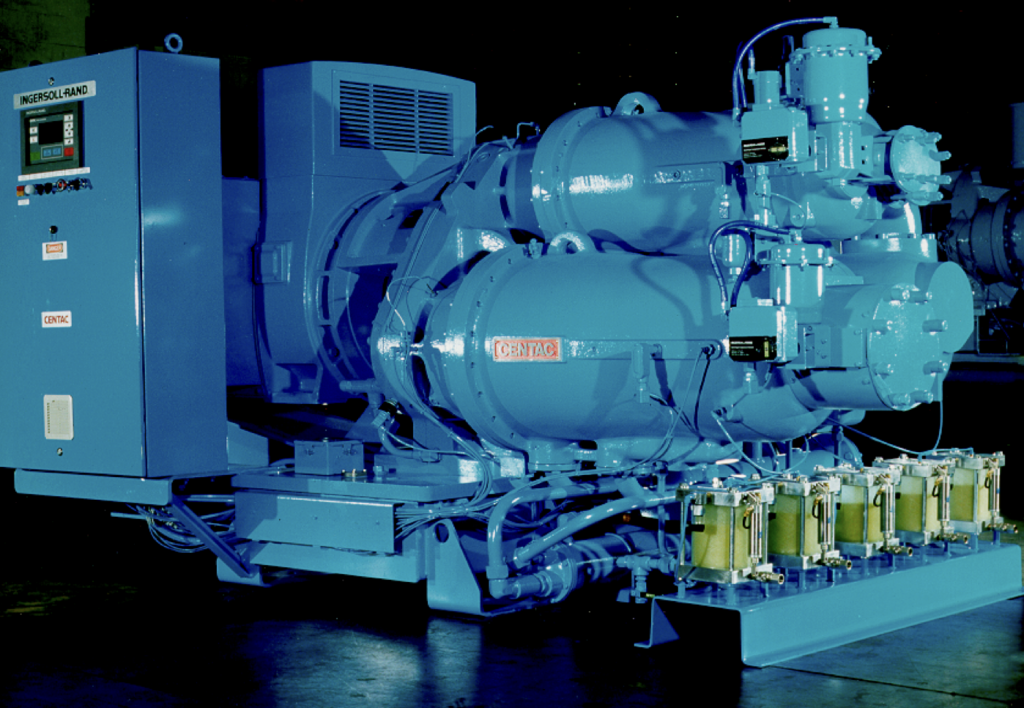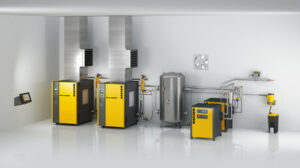Integrally geared centrifugal air compressors are widely used throughout industrial and manufacturing facilities as the preferred technology for plant and instrument air systems. The integrally geared centrifugal design offers high flow rates with superior efficiency in an inherently robust design. This compressor technology is intended to provide continuous operation over many years before requiring off-line inspection or major service. A typical centrifugal air compressor features multiple stages of compression, which is a key element in operational efficiency. During operation, the interstage coolers successively remove the heat of compression as well as condense, separate, and remove a majority of the entrained water vapor through stage condensate drains. Consequently, the performance of each interstage cooler and drain is crucial in maintaining the optimal efficiency and reliability of the compressor.

One of the primary modes of cooler degradation is Foreign Matter Build-up (FMB). Accumulation of FMB on the air or water side of these coolers is a common problem experienced by general industry centrifugal compressors. The continual ingestion of poor-quality inlet air most often causes the occurrence of FMB. Over time, FMB can accumulate on the internal surfaces starting with the aero components through the air, water, and condensate passages internal to the machine. Added restrictions to the air or coolant flows will negatively impact the heat transfer capability of the cooler. If this condition is unaddressed for a long enough period, there is a fair chance it will culminate in machine failure.
Considering the impacts of FMB in greater detail, the obvious effect is that the air passages in the cooler get smaller or become partially blocked as the build-up continues. Although the manufacturer will certainly include some operational tolerance in cooler design, an increase in airflow restriction will directly increase pressure drop across an affected intercooler. Severe buildup in an intercooler may result in one or more of the compressor stages being at or near surge at operating pressure. At this point, the machine must be taken offline in order for the situation to be remedied.

Restriction to the airside of a cooler can be detrimental, but a machine state with an airside obstruction great enough to affect performance is not commonly observed. The most significant and most common FMB impact, which far outweighs airside restriction, is the FMB impact to intercooler heat transfer capability. As build-up accumulates in the internal air passages, the FMB creates an insulating barrier between the tube & fin surfaces and the cooling medium (most often a water or water-glycol mix). The heat of compression can raise stage-discharge air temperatures above 350°F in some cases. Air temperatures will vary from stage to stage and model to model but are ultimately a function of the stage compression ratio. As the fouling of the cooler increases with the buildup of this insulating barrier, the air flow will not be sufficiently cooled prior to entering the next stage, upsetting the proceeding stage pressure/flow relationship. The end result is a loss of both efficiency and performance, eventually reaching a point where the machine will surge at the operating point. Depending on the sophistication of controls, this scenario will effectively eliminate the compressor from supplying any compressed air to the system.
The final mode of action to be considered is the impact of FMB stemming from chemical ingestion. When air is compressed and heated in the presence of moisture, some common industrial site gases form acids that will attack certain metals and seal components of the compressor. An acid attack to the airside of a cooler can occur without significant build-up being seen. This aspect of FMB is usually observed when the cooler fins show signs of becoming brittle. Brittle fin material can flake off and travel through the compressor and impact downstream components. Larger particles are often trapped in the moisture separator, but that is not a guarantee. Clogging of the moisture separator is a flow restriction that acts like a fouled cooler but without the heat transfer degradation effect.
Five vital indicators of intercooler health are:
1) Cold Temperature Difference (CTD)
2) Cooling Water Temperature Rise
3) Differential Air Pressure
4) Cooling Water Pressure Drop
5) pH value of the condensate.
Measuring and trending these variables over time can provide maintenance teams with an effective and repeatable strategy for sustaining peak efficiency in their compressed air systems.

For compressors where a historical trend of operating data is not available, a simple Cold Temperature Difference (CTD) calculation will indicate if the water side of a given cooler is fouled. CTD = Cooler Discharge Air Temperature – Cooler Inlet Water Temperature. The optimal value will vary across models, but generally, a value above 22°F indicates a problem. The Operators Manual or detailed performance data supplied by the manufacturer will typically outline all cooler CTDs specific to a given compressor.
The differential air and water pressures across an intercooler are the measure of respective pressures between the inlet and discharge of the cooler. This may be calculated manually using the interstage pressures displayed via the local compressor controller. For older equipment with legacy control systems, interstage pressure gages or transmitters may be installed in the interstage piping and manually recorded. For optimal performance, the differential air and water pressures should be maintained within the ranges provided by the OEM.
To determine if the ingestion of harmful chemicals is impacting the coolers, standard Litmus paper can be used to test the condensate. A low reading of < 6 pH may indicate acid-forming compounds are being ingested. A high pH reading of > 8 pH can indicate a cooling water-to-airside leak, commonly seen in treated cooling water systems. In this scenario, coolant (be it water or water-glycol) leaks into the air stream and causes very accelerated FMB and possible mechanical damage as a result of impingement. The performance of a natural surge test indicates and provides information relative to how much degradation of performance has occurred. Degradation, in most instances, will be the result of FMB.

The performance, efficiency, and reliability of an integrally geared centrifugal compressor are linked directly to the health of the coolers. Failure to monitor and address cooler issues as they arise can have significant negative impacts on operability, leading up to and culminating in a major failure. Proper maintenance and prompt action is the best strategy for companies to avoid costly and unplanned downtime and repairs. By taking proactive steps to address the cooler issues outline here, businesses can enhance the efficiency and reliability of their centrifugal air compressors, ultimately saving costs and increasing productivity.
Kevin Dodd 5/2023



